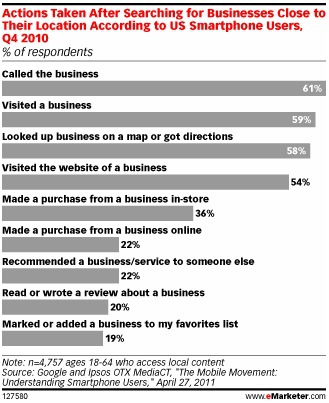According to a recent study, targeting smartphone users could be the ultimate platform for retailers and local businesses. The research indicates that mobile searchers are much further in the buying cycle than any business or marketer could have ever dreamed.
As mobile devices become more popular and more technologically advanced, mobile search is becoming a much more prominent activity. Search has always been a top activity on the internet, but mobile searches are increasing each year, as are mobile search advertising expenditures. Mobile search ad spending is expected to make up 27% of the US mobile advertising market in 2011, and continue to surge toward 34% by the year 2014.
Users who are searching for a product on their smartphones may be sitting at home, but odds are they’re out and about, getting things done and purchasing goods. While consumers (especially desktop users) usually purchase their machines for use at home or work, consumers purchase mobile devices with the intent of using them on the go. Smartphone users could be running around town looking for a product or, better yet, in a store researching something that’s right in front of them.
What Actions Do Users Take After Makings a Mobile Search?
A survey conducted by Google and Ipsos OTX MediaCT gives us an idea of what smartphone users do after running a search on a mobile device.
To the adoration of retailers and marketers alike, the most common activity after performing a search was to visit a business’ website or store. An amazing 55% of people who searched for product information via a mobile device actually walked into a physical store shortly after. Another 39% visited the retailer’s website.
The second most common activity was to continue research on either a PC or smartphone Although purchasing was the least likely activity after a mobile search, the report indicates 53% of all mobile searches related to a product resulted in a purchase. 40% purchased something in a brick-and-mortar store, 35% made their purchase online, 20% actually made a purchase using their smartphones. These numbers are
In other words, more than half of smartphone users purchased a product after doing a search on their smartphones, and even more users visited a physical store. For a retailer, marketer, or ecommerce store, these numbers should open your eyes to the power of mobile search.
Mobile Search for Local Businesses
The study further segmented searchers who were searching for a business close to their location.

Of mobile searches for a local business, 61% called a store after there search, and almost as many searchers actually visited a business—59%. 58% searched for directions or looked at a map, which falls in line with 59% that visited the stores physical location. (Perhaps that 1% might have gotten lost on the way?) Furthermore, 54% of local, mobile searchers visited the business’ website.
An astounding 36% of survey respondents stated they made a purchase at the physical location and 27% said they made a purchase at the business’ online store.The number of respondents who promoted the businesses on their smartphones is also remarkable. 22% of mobile searchers recommended a business to someone else. The study indicates that 20% of mobile searchers either read or wrote a review, but reading versus writing is a much different activity so the only conclusion we can draw from that is having positive reviews is important.
As you can see, targeting mobile searchers could potentially be an untapped goldmine a business. But how do you do that? Are there any specific ways to target mobile searchers? Absolutely! Stay tuned for Part II when we’ll walk through the best practices to optimize a site for mobile search.
Check out the SEO Tools guide at Search Engine Journal.




